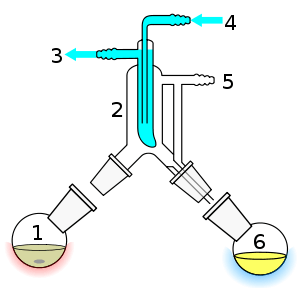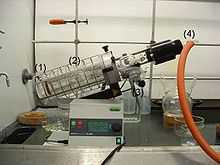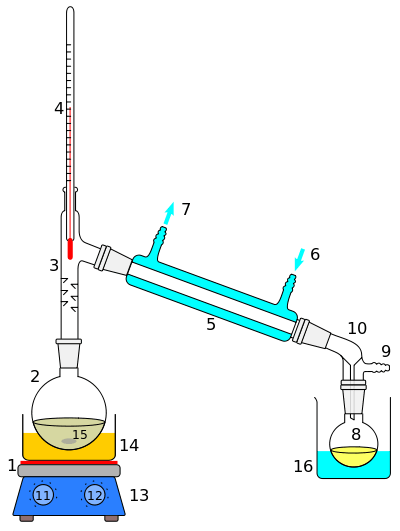Vacuum distillation

Vacuum distillation is a method of distillation whereby the pressure above the liquid mixture to be distilled is reduced to less than its vapor pressure (usually less than atmospheric pressure) causing evaporation of the most volatile liquid(s) (those with the lowest boiling points).[1] This distillation method works on the principle that boiling occurs when the vapor pressure of a liquid exceeds the ambient pressure. Vacuum distillation is used with or without heating the mixture.
Laboratory-scale applications
Laboratory-scale vacuum distillation is used when liquids to be distilled have high atmospheric boiling points or chemically change at temperatures near their atmospheric boiling points.[2][3][4] Temperature sensitive materials (such as beta carotene) also require vacuum distillation to remove solvents from the mixture without damaging the product. Another reason vacuum distillation is used is that compared to steam distillation there is a lower level of residue build up. This is important in commercial applications where heat transfer is produced using heat exchangers.
There are many laboratory applications for vacuum distillation as well as many types of distillation set-ups and apparatuses.
Safety is an important consideration when using glassware as part of the set-up. All of the glass components should be carefully examined for scratches and cracks which could result in implosions when the vacuum is applied. Wrapping as much of the glassware with tape as is practical helps to prevent dangerous scattering of glass shards in the event of an implosion.
Rotary evaporation
Rotary evaporation[5] is a type of vacuum distillation apparatus used to remove bulk solvents from the liquid being distilled. It is also used by environmental regulatory agencies for determining the amount of solvents in paint, coatings and inks.[6]
Rotary evaporation set-ups include an apparatus referred to as a Rotovap which rotates the distillation flask (sometimes called the still pot) to enhance the distillation. Rotating the flask throws up liquid on the walls of the flask and thus increases the surface area for evaporation.
Heat is often applied to the rotating distillation flask by partially immersing it in a heated bath of water or oil. Typically, the vacuum in such systems is generated by a water aspirator or a vacuum pump of some type.
Distillation of high-boiling and/or air sensitive materials
Some compounds have high boiling point temperatures as well as being air sensitive. A simple laboratory vacuum distillation glassware set-up can be used, in which the vacuum can be replaced with an inert gas after the distillation is complete.
However, this is not a completely satisfactory system if it is desired to collect fractions under a reduced pressure.
For better results or for very air sensitive compounds, either a Perkin triangle distillation set-up or a short-path distillation set-up can be used.
Perkin triangle distillation set-up
The Perkin triangle set-up (Image 5) uses a series of Teflon valves to allow the distilled fractions to be isolated from the distillation flask without the main body of the distillation set-up being removed from either the vacuum or the heat source, and thus can remain in a state of reflux.
To do this, the distillate receiver vessel is first isolated from the vacuum by means of the Teflon valves.
The vacuum over the sample is then replaced with an inert gas (such as nitrogen or argon) and the distillate receiver can then be stoppered and removed from the system.
Vacuum distillation set-up using a short-path head
Vacuum distillation of moderately air/water-sensitive liquid can be done using standard Schlenk-line techniques (Image 6). When assembling the set-up apparatus, all of the connecting lines are clamped so that they cannot pop off.
Once the apparatus is assembled, and the liquid to be distilled is in the still pot, the desired vacuum is established in the system by using the vacuum connection on the short-path distillation head. Care is taken to prevent potential "bumping" as the liquid in the still pot degases.
While establishing the vacuum, the flow of coolant is started through the short-path distillation head. Once the desired vacuum is established, heat is applied to the still pot.
If needed, the first portion of distillate can be discarded by purging with inert gas and changing out the distillate receiver.
When the distillation is complete: the heat is removed, the vacuum connection is closed, and inert gas is purged through the distillation head and the distillate receiver. While under the inert gas purge, remove the distillate receiver and cap it with an air-tight cap. The distillate receiver can be stored under vacuum or under inert gas by using the side-arm on the distillation flask.
Industrial-scale applications


Industrial-scale vacuum distillation[8] has several advantages. Close boiling mixtures may require many equilibrium stages to separate the key components. One tool to reduce the number of stages needed is to utilize vacuum distillation.[9] Vacuum distillation columns (as depicted in Figures 2 and 3) typically used in oil refineries have diameters ranging up to about 14 metres (46 feet), heights ranging up to about 50 metres (164 feet), and feed rates ranging up to about 25,400 cubic metres per day (160,000 barrels per day).
Vacuum distillation increases the relative volatility of the key components in many applications. The higher the relative volatility, the more separable are the two components; this connotes fewer stages in a distillation column in order to effect the same separation between the overhead and bottoms products. Lower pressures increase relative volatilities in most systems.
A second advantage of vacuum distillation is the reduced temperature requirement at lower pressures. For many systems, the products degrade or polymerize at elevated temperatures.
Vacuum distillation can improve a separation by:
- Prevention of product degradation or polymer formation because of reduced pressure leading to lower tower bottoms temperatures,
- Reduction of product degradation or polymer formation because of reduced mean residence time especially in columns using packing rather than trays.
- Increasing capacity, yield, and purity.
Another advantage of vacuum distillation is the reduced capital cost, at the expense of slightly more operating cost. Utilizing vacuum distillation can reduce the height and diameter, and thus the capital cost of a distillation column.
Vacuum distillation in petroleum refining
Petroleum crude oil is a complex mixture of hundreds of different hydrocarbon compounds generally having from 3 to 60 carbon atoms per molecule, although there may be small amounts of hydrocarbons outside that range.[10][11][12] The refining of crude oil begins with distilling the incoming crude oil in a so-called atmospheric distillation column operating at pressures slightly above atmospheric pressure.[8][10][11]
Vacuum distillation can also be referred as "low temperature distillation"
In distilling the crude oil, it is important not to subject the crude oil to temperatures above 370 to 380 °C because the high molecular weight components in the crude oil will undergo thermal cracking and form petroleum coke at temperatures above that. Formation of coke would result in plugging the tubes in the furnace that heats the feed stream to the crude oil distillation column. Plugging would also occur in the piping from the furnace to the distillation column as well as in the column itself.
The constraint imposed by limiting the column inlet crude oil to a temperature of less than 370 to 380 °C yields a residual oil from the bottom of the atmospheric distillation column consisting entirely of hydrocarbons that boil above 370 to 380 °C.
To further distill the residual oil from the atmospheric distillation column, the distillation must be performed at absolute pressures as low as 10 to 40 mmHg (also referred to as Torr) so as to limit the operating temperature to less than 370 to 380 °C.
Figure 2 is a simplified process diagram of a petroleum refinery vacuum distillation column that depicts the internals of the column and Figure 3 is a photograph of a large vacuum distillation column in a petroleum refinery.
The 10 to 40 mmHg absolute pressure in a vacuum distillation column increases the volume of vapor formed per volume of liquid distilled. The result is that such columns have very large diameters.[13]
Distillation columns such those in Images 1 and 2, may have diameters of 15 meters or more, heights ranging up to about 50 meters, and feed rates ranging up to about 25,400 cubic meters per day (160,000 barrels per day).
The vacuum distillation column internals must provide good vapor–liquid contacting while, at the same time, maintaining a very low pressure increase from the top of the column top to the bottom. Therefore, the vacuum column uses distillation trays only where withdrawing products from the side of the column (referred to as side draws). Most of the column uses packing material for the vapor–liquid contacting because such packing has a lower pressure drop than distillation trays. This packing material can be either structured sheet metal or randomly dumped packing such as Raschig rings.
The absolute pressure of 10 to 40 mmHg in the vacuum column is most often achieved by using multiple stages of steam jet ejectors.[14]
Many industries, other than the petroleum refining industry, use vacuum distillation on a much a smaller scale.
Molecular distillation
Molecular distillation is vacuum distillation below the pressure of 0.01 torr[15] (1.3 Pa). 0.01 torr is one order of magnitude above high vacuum, where fluids are in the free molecular flow regime, i.e. the mean free path of molecules is comparable to the size of the equipment. The gaseous phase no longer exerts significant pressure on the substance to be evaporated, and consequently, rate of evaporation no longer depends on pressure. That is, because the continuum assumptions of fluid dynamics no longer apply, mass transport is governed by molecular dynamics rather than fluid dynamics. Thus, a short path between the hot surface and the cold surface is necessary, typically by suspending a hot plate covered with a film of feed next to a cold plate with a line of sight in between. Molecular distillation is used industrially for purification of oils.
Gallery
-

A simple short path vacuum distillation apparatus
-

Kugelrohr – a short path vacuum distillation apparatus
-

Perkin triangle – for air-sensitive vacuum distillation
-

Vacuum distillation apparatus
See also
References
- This article incorporates material from the Citizendium article "Vacuum distillation", which is licensed under the Creative Commons Attribution-ShareAlike 3.0 Unported License but not under the GFDL.
- ↑ Laurence M. Harwood, Christopher J. Moody (13 June 1989). Experimental organic chemistry: Principles and Practice (Illustrated edition ed.). WileyBlackwell. pp. 147–149. ISBN 978-0-632-02017-1.
- ↑ Distillation (CU Boulder Organic Chemistry Teaching Labs)
- ↑ Vacuum Distillation: New Method for Analyzing Organic Chemicals in a Wide Array of Samples (United States Environmental Protection Agency)
- ↑ What is vacuum distillation? (Argonne National Laboratory's NEWTON Ask-A-Scientist)
- ↑ Operation of a Rotary Evaporator (Rotovap) (from the website of the University of British Columbia)
- ↑ SCAQMD Test method 302-91
- ↑ Energy Institute website page
- ↑ 8.0 8.1 Kister, Henry Z. (1992). Distillation Design (1st Edition ed.). McGraw-Hill. ISBN 0-07-034909-6.
- ↑ Karl Kolmetz, Andrew W. Sloley et al. (2004), Designing Distillation Columns for Vacuum Service, 11th India Oil and Gas Symposium and International Exhibition, September 2004, Mumbai, India (also published in Hydrocarbon Processing, May 2005)
- ↑ 10.0 10.1 Gary, J.H. and Handwerk, G.E. (1984). Petroleum Refining Technology and Economics (2nd Edition ed.). Marcel Dekker, Inc. ISBN 0-8247-7150-8.
- ↑ 11.0 11.1 Leffler, W.L. (1985). Petroleum refining for the nontechnical person (2nd Edition ed.). PennWell Books. ISBN 0-87814-280-0.
- ↑ James G, Speight (2006). The Chemistry and Technology of Petroleum (Fourth Edition ed.). CRC Press. 0-8493-9067-2.
- ↑ Karl Kolmetz, Andrew W. Sloley et al (2004), Designing Distillation Columns for Vacuum Service, 11th India Oil and Gas Symposium and International Exhibition, September 2004, Mumbai, India (also published in Hydrocarbon Processing, May 2005)
- ↑ Photo gallery (from website of Graham Manufacturing Company)
- ↑ Vogel's 5th ed.
External links
| ||||||||||||||||||||
